
| HOME | SEARCH | ABOUT US | CONTACT US | HELP | ||
| |
| This is an obsolete version of the rule. Please click on the rule number to view the current version. |
|
36.1.101 ORGANIZATION OF DEPARTMENT (1) History and Purpose. The Department of Natural Resources and Conservation was established under the Executive Reorganization Act of 1971 by executive order of the Governor on December 20, 1971. It was extensively reorganized by the 1995 Legislature and is provided for in 2-15-3301, MCA. Its mission is to help ensure Montana's land and water resources provide benefits for present and future generations. The department directs a wide variety of programs in meeting these and related goals and objectives. (2) Organization. The department is headed by the director, who is appointed by the Governor. Within the Director's Office are a deputy director and four work units: Financial Services Office; Human Resources Office; Legal Unit; and Office of Information Technology. The public information officer, Financial Services Office, and the Office of Information Technology report jointly to the director and deputy director. The Human Resources Office and Legal Unit report only to the director. Below the director the department is divided into four divisions, each of which is headed by an administrator. Each division is divided into bureaus, each of which is headed by a chief; and, in three divisions, programs are administered by regional or area office staff. Two boards are attached to the department for administrative purposes only as provided in 2-15-3303 and 2-15-3307, MCA. Another board appears in these rules because it has authority under Title 77, chapter 1, part 2, MCA, to administer state trust lands and the funds arising from the leasing, use, sale, and disposition of those lands. All three boards exercise rulemaking and adjudicatory functions. Four advisory councils advise the department but are not directly attached. Advisory councils have advisory roles only and no rulemaking authority. (3) Department Organizational Units. The organizational structure and allocation of functions is as follows. The various boards, commissions, and advisory councils are also listed, although they are not subunits of the department. (a) Director's Office. The director is responsible for the administration of all the functions vested by law in the department and for establishing policy to be followed by the department. In addition, the work units in the Director's Office provide legal, personnel, financial, information technology, and communications services to the director and the divisions within the agency. (b) Conservation and Resource Development Division. The division provides administrative, financial, technical, and legal assistance to the state's 58 soil and water conservation districts in their efforts to protect the state's natural resources. The division also administers a number of grant and loan programs which assist communities and local governments to benefit natural resources. (i) Conservation Districts Bureau. This bureau is responsible for providing administrative, financial, technical, and legal guidance assistance to conservation districts in their work to encourage proper land use practices. The districts establish programs to prevent soil erosion, minimize saline seep, control noxious weeds, maintain water quality, prevent floodwater and sediment damage, assist rural economic development, provide watershed and rangeland management, and assist with development, use, and disposal of water. The bureau also implements the state rangeland resource program; administers loans to qualified farmers and ranchers; provides grants to qualified conservation districts; and awards loans and grants for projects that develop, maintain, or improve water and other renewable resources. (ii) Financial Development Bureau. This bureau prepares and manages the cash flow of its division programs. The bureau also issues loans to local governments for water and wastewater infrastructure improvement and manages the financial administration of the Water Pollution Control State Revolving Fund and Drinking Water State Revolving Fund loan programs. (iii) Resource Development Bureau. This bureau administers several grant and loan programs that assist communities and local governments to improve infrastructure resulting in the protection, enhancement, or development of renewable resources or that otherwise benefit natural resources through reclamation, planning, research and education. This bureau also assists conservation districts in the administration of water reservations to ensure the quality of public resources. (c) Forestry Division. This division is responsible for ensuring the sustainability of Montana forests, rural lands, and communities through cooperative wildland fire protection, sound forest management practices, and by promoting a viable forest-based economy. (i) Business Management Bureau. This bureau manages the division's fiscal activities and provides division financial information to department headquarters, the Governor's Office, Legislature, and federal agencies. The bureau also implements division policy relating to all fiscal and business management functions; develops policy and manages operating procedures for statewide long-range building projects to include new construction, small projects and deferred maintenance; provides guidance and assistance to division personnel regarding compensation and personnel issues; and ensures that timely and efficient administrative support services are provided to division personnel. (ii) Fire and Aviation Management Bureau. This bureau provides resources, leadership, and coordination to statewide wildfire services. This is accomplished through wildfire prevention, training, preparedness, and safe, aggressive suppression actions to protect lives, property and natural resources. (iii) Forestry Assistance Bureau. This bureau promotes sustainable forests and watersheds for the benefits of the state through leadership and service to communities and landowners through education programs, technical and financial assistance, and collaboration with other forestry agencies and groups. (d) Trust Land Management Division. This division is responsible for managing the surface and mineral resources of forested, grazing, agricultural, and other classified state trust lands to produce revenue for the benefit of state public schools and other endowed institutions. (i) Agriculture and Grazing Bureau. This bureau is responsible for leasing and managing surface leasing for crop and rangeland uses on school trust land throughout the state. The bureau also manages recreational use licenses for trust land. (ii) Forest Management Bureau. This bureau manages forested trust lands to maximize long-term revenue while promoting healthy and diverse forests. Revenues are derived mainly from the sale of forest products. Several resource management sections provide support and program direction by developing resource management standards; conducting site-specific reviews; and formulating recommendations as members of interdisciplinary teams that develop land management proposals. The Forest Management Bureau reports to both the Trust Land Management Division and Forestry Division administrators. (iii) Minerals Management Bureau. This bureau is responsible for leasing, permitting, and managing state-owned minerals. These duties include oil and gas, metalliferous and non-metalliferous, coal, and sand and gravel agreements on trust and other state-owned land. The bureau contains a royalty auditing and accounting section. (iv) Real Estate Management Bureau. This bureau is responsible for all activity on trust lands that is not classified as grazing, agriculture, or timber. This includes commercial and residential leasing, short-term licenses, land exchanges and sales, and right-of-way agreements. (e) Water Resources Division. This division promotes and coordinates the beneficial use, conservation, protection, and development of state water resources. Through coordination of the development and utilization of the state's water, the division protects existing uses and promotes adequate future supplies for domestic, industrial, agricultural, recreation, the conservation of water for wildlife, aquatic life and other beneficial uses. (i) State Water Projects Bureau. This bureau administers the operation and maintenance of state-owned water projects which include dams, irrigation canals, and a hydropower facility. The bureau also assists the Department of Fish, Wildlife and Parks with their dam safety issues. (ii) Water Adjudication Bureau. This bureau assists the Montana Water Court in the adjudication of all claims to pre-July 1, 1973, water rights. The bureau examines all claims pursuant to Supreme Court rules and provides a summary report to the Water Court on each of the basins in the state. The bureau also provides post decree assistance to the Water Court as requested and to district courts as Water Court decrees are placed under enforcement. (iii) Water Management Bureau. This bureau develops and analyzes policies on statewide water resource issues and represents Montana’s basin interests regionally and internationally. The bureau also provides education, assistance, and outreach for the public, department, and other governmental entities. (iv) Water Operations Bureau. This bureau administers the Board of Water Well Contractors, regulates dam safety, assists locally administered floodplain management programs, and provides technical information and water measurement requirements regarding stream diversion where chronic dewatering has caused disputes. (v) Water Rights Bureau. This bureau assures the orderly appropriation and beneficial use of Montana's waters through administration of the Montana Water Use Act, Title 85, Chapter 2, MCA. (f) Field Operations. (i) Conservation and Resource Development Division Field Offices. The division has four field offices in Billings, Glasgow, Miles City, and Roundup. The managers report to the three bureau chiefs and are responsible for integrating and implementing the programs of the division. (ii) Trust Land Management Division and Forestry Division Area and Unit Offices. These divisions have six joint area offices: Central Land Office (Helena); Eastern Land Office (Miles City); Northeastern Land Office (Lewistown); Northwestern Land Office (Kalispell); Southern Land Office (Billings); and Southwestern Land Office (Missoula). The managers report jointly to the division administrators of the Trust Land Management and Forestry divisions and are responsible for integrating and implementing the programs of those divisions. Area offices have associated unit offices whose managers report to the appropriate area office manager. (iii) Water Resources Division Regional and Unit Offices. This division has eight field offices in Billings, Bozeman, Glasgow, Havre, Helena, Kalispell, Lewistown, and Missoula. The managers report to the division administrator and are responsible for integrating and implementing the programs of the Water Resources Division. (g) Boards. (i) Board of Land Commissioners. Under the Constitution and statute, the department's administration of state trust land in Montana is subject to review and approval by the board. Under the direction of the board, the director is responsible for the administration of state trust land management functions vested in the department under the Trust Land Management Division. The board has rulemaking authority. (ii) Board of Oil and Gas Conservation. This board consists of seven members appointed by the Governor for four-year terms. The board is attached to the department for administrative purposes only. Responsibilities include promoting conservation of oil and gas; preventing waste, contamination, and damage to land and underground strata from oil and gas activities; establishing well spacing units and protecting the correlative rights of mineral owners; and, subject to approval by the U.S. Environmental Protection Agency, regulating all Class II injection wells. The board has rulemaking authority. (iii) Board of Water Well Contractors. This board consists of five members and is attached to the department for administrative purposes under the Water Resources Division. Three of the members are appointed by the directors of their respective agencies for indefinite terms, and two Governor-appointed members who represent the water well industry. The board adopts administrative rules regulating licenses and establishing minimum construction standards for water wells and monitoring wells; inspects wells upon request or complaint, and at other times as deemed necessary; and licenses well drillers, contractors, and monitoring well constructors. (h) Commissions, Committees, and Advisory Councils. (i) Drought Advisory Committee. This committee is chaired by the Governor's representative and consists of members appointed by the Department of Natural Resources and Conservation, Department of Agriculture, Department of Fish, Wildlife and Parks, Department of Military Affairs, Department of Environmental Quality, and Department of Livestock, as per 2-15-3303, MCA. Its purpose is to serve as a clearinghouse for the sharing of water supply and moisture conditions on a monthly basis among state and local agency officials with responsibility to manage natural resources and support constituents most likely affected by drought. (ii) Flathead Basin Commission. This commission consists of members appointed as described in 2-15-3330, MCA. Its purpose is to protect the existing high quality of the Flathead Lake aquatic environment; the waters that flow into, out of, or are tributary to the lake; and the natural resources and environment of the Flathead Basin. (iii) Montana Grass Conservation Commission. This commission is a Governor-appointed board as described in 76-16-112, MCA, whose mission is to conserve, protect, restore, and facilitate the proper utilization of grass, forage, and range resources in the state by organizing and administering the state grazing districts and by promoting cooperation between the Bureau of Land Management, U.S. Forest Service, Department of Natural Resources and Conservation, and the state districts. (iv) Rangeland Resource Committee. This committee is composed of ranchers located across the state and appointed by the Governor as per 2-15-3305, MCA. They provide guidance to the Rangeland Resources Program in the Conservation and Resource Development Division. (v) Reserved Water Rights Compact Commission. This commission is administratively attached to Water Resources Division. The nine commission members, who serve four-year terms, are appointed as per 2-15-212, MCA. The commission is part of the statewide stream adjudication. The commission negotiates compacts to quantify the federal reserved water rights of the Indian tribes and federal agencies that claim reserved rights in Montana. (vi) Resource Conservation Advisory Council. This council meets four times per year to provide advice and assistance on conservation matters and makes recommendations to set guidelines for the Conservation Districts Bureau of the Conservation and Resource Development Division. (4) Information and submissions. General inquiries regarding the department, boards, commission, or advisory councils may be addressed to the director or e-mailed to dnrc_publicinfo@mt.gov. Specific inquiries regarding the functions of a division may be addressed to the administrator of that division. All requests for department policy, hearings, declaratory rulings, and participation in rulemaking should be addressed to the director unless the notice in the Montana Administrative Register makes specific provisions for submissions. (5) Personnel Roster. The director and division administrators can be contacted at 1625 11th Avenue, Helena, Montana 59620; phone 406-444-2074; fax 406-444-2684. Information regarding the department and its personnel can also be found at www.dnrc.mt.gov. (6) Charts of Agency Organization. Organizational charts of the Department of Natural Resources and Conservation are attached on the following pages and are incorporated into this rule.
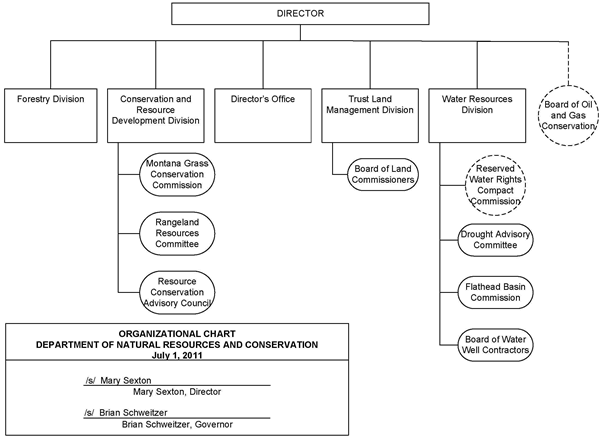
Director's Office
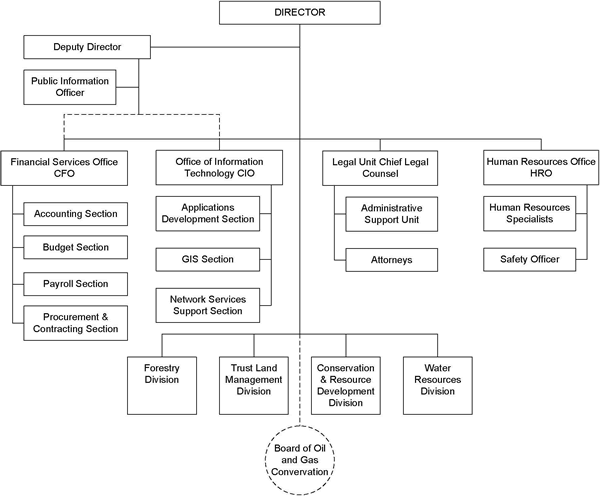 Board of Oil and Gas
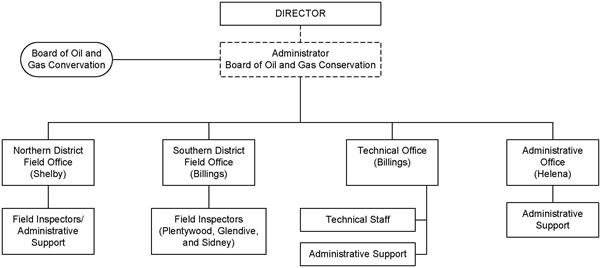 Conservation and Resource Development Division
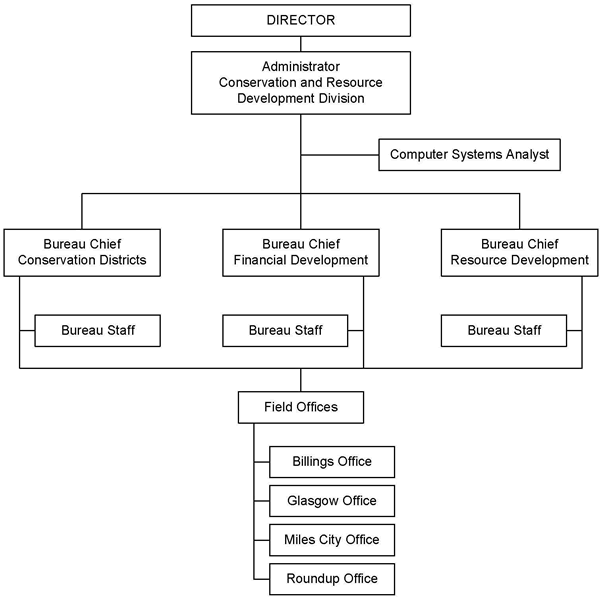 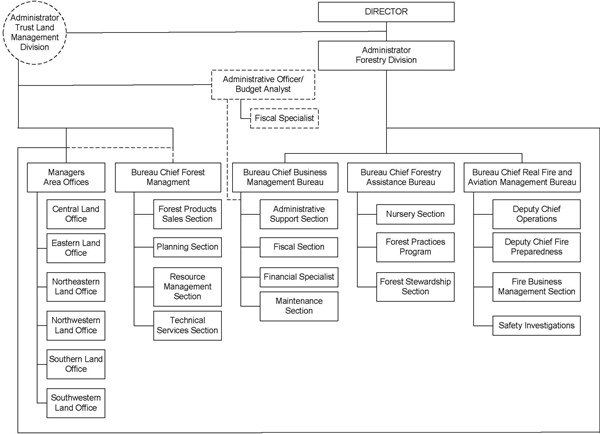 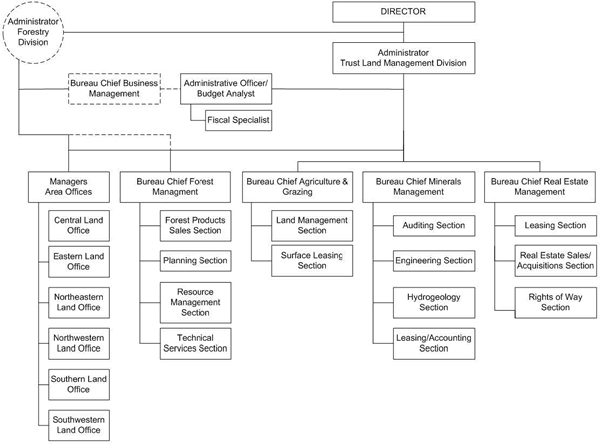 Water Resource Division
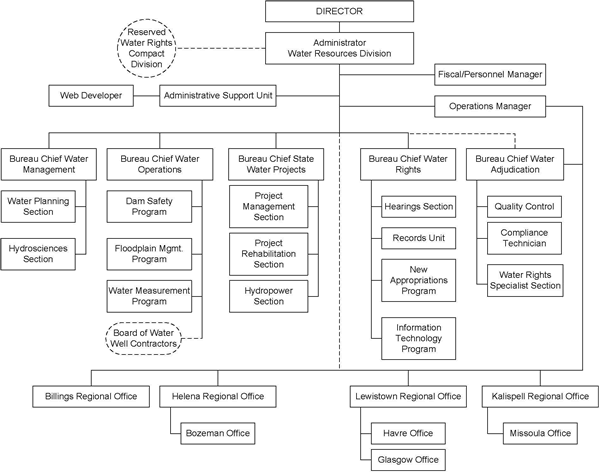
History: 2-4-201, MCA; IMP, 2-4-201, MCA; Eff. 12/31/72; AMD, Eff. 7/5/73; AMD, Eff. 4/15/74; AMD, Eff. 12/5/74; AMD, Eff. 10/5/75; AMD, Eff. 10/24/77; AMD, Eff. 7/27/78; AMD, Eff. 7/2/79; AMD, Eff. 3/31/80; AMD, Eff. 7/1/81; AMD, Eff. 4/82; AMD, Eff. 9/30/88; AMD, Eff. 9/30/90; AMD, Eff. 7/1/95; AMD, Eff. 6/30/12; AMD, Eff. 6/30/13. |
A directory of state agencies is available online at http://www.mt.gov/govt/agencylisting.asp.
For questions about the organization of the ARM or this web site, contact sosarm@mt.gov.